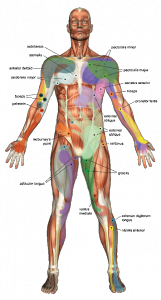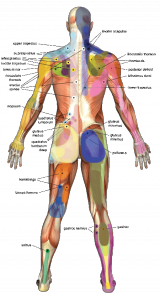
The Squat (those legs, that butt)
April 23, 2015
Prick it where it’s tight! Dry-needling and how it differs from acupuncture
May 6, 2015Many people present to us with pain or inability to perform certain movements due to pain, wondering whether it’s a muscle tear, joint or bone damage. Little do they realize that a layer of connective tissue that connects the muscle to the skin, and encapsules the muscles, called the fascia, is the biggest component of pain, which transmits mechanical tension generated by muscle movement. The fascia is made primarily of collagen, stabilizing, enclosing and separating muscles from internal organs and reducing friction between muscles preventing them from breaking down. It also supports nerves and blood vessels that run through muscles by acting like a supportive wrapping sheath. If you want to picture it, it’s the white thin sheath around a raw chicken breast.
In life we all place demands upon our body that can impact our physical well-being. This is called stress, and can range from emotional (depression), physical (exercise, bad posture) or chemical sources (poor eating habits or drugs). Whether you spend hours daily bent over a desk at work , pounding the pavement on long runs or pushing your body to the limit in high-impact sports such as weight-lifting, this repetitive motion and overuse can lead to adhesions in the muscle that become painful and often lead to injury. When the myofascia (fascia around the muscle) is stressed from overuse or trauma, such as chronic postural abnormalities or even surgery, it can weaken, tear and adhere together. This is of clinical importance to us as it loses stiffness and doesn’t allow the muscles to shear properly. The resulting inflammation or trauma causes fibrosis and adhesions in the muscle which feels like a “knot”; we call these adhesions “Trigger points”. This compromises the structure of the muscle tissue and the fascial tissue fails to differentiate the adjacent structures effectively.
Trigger points lead to an increase in muscle stiffness and tenderness and a decrease in range-of-motion. In addition, the discomfort from trigger points can radiate from the adhesion. This is called referral pain and the most common pathways are shown in this image.
If adhesions and tightness in the muscle are not addressed through myofascial release and stretching, the body will compensate and additional tension will be placed on another muscle through the fascia. This chain reaction can lead to decreased range of motion and performance from the muscles you use to perform every day.
Many therapies can be used to release the fascia and adhesions such as Graston technique, deep tissue therapies, active release technique, dry needling, chiropractic manipulations and osteopathic mobilizations amongst many other things! We can also use objects such as the foam roller, firm acupressure balls and specific static stretching holds to maintain facial fluidity.
Talk to one of our therapists who each specialize in their own release technique to address either acute or chronic pain that you can’t explain!






